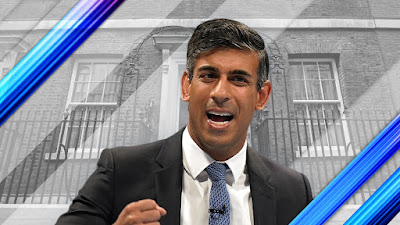How the Southampton-born banker made his way to the top job in Downing Street.
Just seven weeks ago, Rishi Sunak was licking his wounds after losing the Tory leadership race to Liz Truss.
Now, he has been chosen by Conservative MPs to run the party and is set to become the youngest prime minister of the modern era.
As he prepares for his tenure in Number 10 as the third PM of 2022, let’s look back at how he made it to the top job.
Born in 1980 in Southampton, he is the eldest of three children to his parents of Punjabi descent.
Mr Sunak’s father was a family doctor and his mother ran a pharmacy, where he helped her with the books.
He attended England’s oldest public school, Winchester College, where he became the first Indian-origin head boy and was editor of the school paper.
He has since said his experience at the boarding school was “intellectually transforming” and put him “on a different trajectory”.
Mr Sunak went on to study philosophy, politics and economics at Lincoln College at Oxford University, where he obtained a first-class degree.
After completing an MBA at Stanford University, where he met his future wife, Akshata Murthy, Mr Sunak worked for the investment bank Goldman Sachs as an analyst.
He was said to have already had job offers from investment banks under his belt while still in his second year at Oxford.
He moved to work for hedge funds in 2006 when he joined TCI, known as a very aggressive fund, and left three years later to cofound a new hedge fund.
Mr Sunak then turned his attention to politics.
Replacing a Tory grandee
In 2014, Mr Sunak was selected as the Conservative Party candidate in the Yorkshire seat of Richmond – previously held by former Tory leader William Hague – before the following year’s general election.
Nicknamed the “maharajah of the Yorkshire Dales”, he recalled being introduced as “the new William Hague” to his constituents after winning the ballot, to which a Yorkshire farmer replied: “Ah yes Haguey!
“Good bloke. I like him. Bit pale, though. This one’s got a nice tan.”
Soon after his entry into the Commons – where, as a Hindu, he took his oath on the Bhagavad Gita – the first big political fight of his career came along in Brexit.
Mr Sunak supported leaving the EU, claiming the UK would be “freer, fairer and more prosperous” outside the bloc.
His side won, and he bided his time on the backbenches, supporting Theresa May’s negotiations and writing papers on the benefits of freeports, before being appointed to government in January 2018 as a junior minister at the housing ministry.
After Mrs May’s demise, he joined with colleagues Oliver Dowden and Robert Jenrick to write an article in The Telegraph, backing Boris Johnson as the only person who could “save” the Tory party.
His support paid off, as when Mr Johnson became prime minister in July 2019, Mr Sunak secured a promotion to become chief secretary to the Treasury, becoming the right-hand man to Mr Javid as chancellor.
It was the exit of that boss that led to his real rise to prominence when he was made chancellor in February 2020 – a month before COVID took hold.
From relative unknown to household name
Sunak won praise throughout the pandemic for rapidly introducing support schemes worth billions of pounds to keep jobs and businesses afloat during 18 months of lockdowns.
The likes of furlough and the “Eat Out to Help Out” scheme led to “dishy Rishi” becoming a household name, and a popular one with the public.
At the height of this popularity, he was seen by many Tory MPs as the sure-fire favourite to succeed Mr Johnson when the time came.
But he seemed to fall from grace as quickly as he rose to fame.
Mr Sunak introduced a number of policies that went down badly with Tory MPs, especially the rise in national insurance to fund more money for the NHS and social care.
He was also fined for attending the prime minister’s birthday party during lockdown in 2020, compromising his ability to separate himself from the partygate scandal.
But it was revelations about his wife that really damaged his standing with the public.
Wife’s non-dom status damages leadership hopes
Ms Murty is a multimillionaire and daughter of billionaire NR Narayana Murthy, the co-founder of the Indian technology giant Infosys.
In April, it was revealed she held non-dom status, meaning she did not have to pay UK tax on her sizeable international income, and it led to an uproar.
She later confirmed she would begin to pay tax on her international earnings as it had “become clear that many do not feel [the non-dom status] is compatible with my husband’s role as chancellor”.
The row led to opposition parties highlighting his family’s wealth, with Mr Sunak facing accusations that his personal circumstances made him an unsuitable candidate to take over and tackle the cost of living crisis.
Although he remained as chancellor, many wrote off his chances of becoming the next Tory leader.
But his resignation in July sparked a ministerial exodus and Mr Johnson’s resignation, paving the way for his first attempt at Downing Street.
In the ensuing leadership race, Mr Sunak came out on top in each of the five parliamentary rounds of the contest, making it to the final two along with Ms Truss.
But as the campaign hit its stride and widened to the party membership, Mr Sunak found himself transformed from favourite to underdog.
While he warned of “tough choices ahead” to tackle record levels of national debt incurred during the pandemic, Ms Truss promised tax cuts as a priority.
He accused his competitor of “fairy-tale” economics and peddling “something-for-nothing” plans that even Jeremy Corbyn would baulk at.
But Ms Truss doubled down, landing blows on Mr Sunak for putting taxes up to the highest level in 70 years.
Staying in the background
She went on to win the party leadership after securing 57% of valid votes cast, compared to 43% for Mr Sunak.
While Ms Truss embarked on a path of economic turmoil thanks to her tax-slashing mini-budget, the former chancellor kept a low profile, only appearing in the Commons for a few backbench debates and staying away from the cameras.
And after her resignation following an historically short tenure, all eyes were back on Mr Sunak as the candidate to bring back stability to the markets and, perhaps, the party.
He announced he was running to replace her on Twitter three days later, having already reached the 100+ nominations needed to get a place on the ballot.
But that was all we saw of the favourite for PM as he again kept out of the spotlight, despite going for the highest profile job in the land.
Up until two minutes before the deadline for nominations, it looked like Mr Sunak would be facing Penny Mordaunt – another former leadership contestant who fancied her chances again.
But she pulled out of the race at the last minute so, instead, he was anointed as both leader and prime minister without challenge – the first Hindu and British Asian to reach the position in UK history.
When he chose to run again, Mr Sunak promised to “fix our economy, unite our party and deliver for our country”.
And after the tumultuous premiership of the woman who beat him first time round, there is a lot to do to achieve that.
All eyes are now on him to see if he can succeed.
Source: Sky News


















